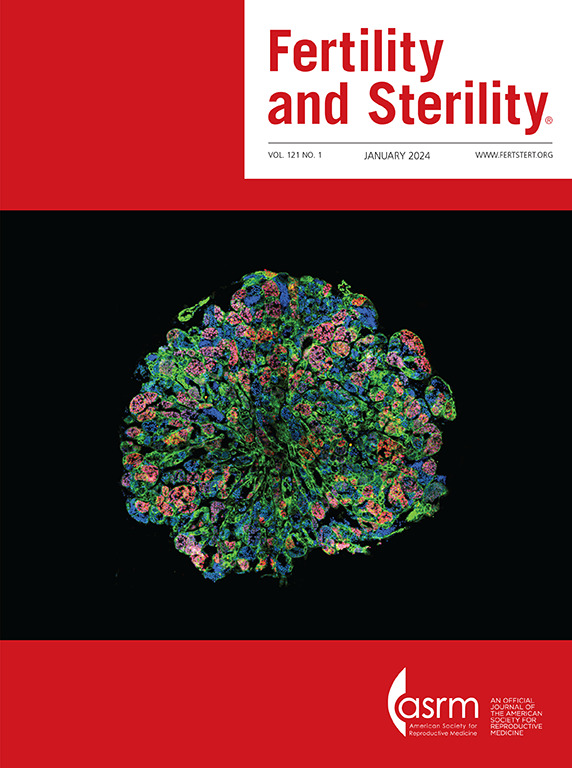Puberty progression in girls with Turner syndrome after ovarian tissue cryopreservation
IF 7
1区 医学
Q1 OBSTETRICS & GYNECOLOGY
引用次数: 0
Abstract
Objective
To study the impact of unilateral ovariectomy for ovarian tissue cryopreservation (OTC) on the function of the remaining ovary in girls with Turner syndrome.
Design
A prospective cohort study as a follow-up of OTC in a research setting (the TurnerFertility trial, NCT03381300).
Subjects
A total of 28 girls with Turner syndrome with follicles in their cryopreserved ovarian cortex tissue, aged 5–19 years. Of the 28 girls, 21 had a 45,X/46,XX mosaic karyotype; 5 had structural aberrations of the X chromosome; 1 had a 45,X monosomy; and 1 had a 45,X/47,XXX karyotype.
Interventions
Girls were monitored annually after OTC for pubertal development and levels of antimüllerian hormone (AMH), follicle-stimulating hormone, luteinizing hormone, estradiol, and inhibin B.
Main Outcome Measures
Thelarche, menarche, and onset of premature ovarian insufficiency.
Results
The girls were monitored for a median duration of 3.4 years (maximum 6.6 years). The pubertal development of five prepubertal girls is still unknown; all were aged <10 years and had low gonadotropin and estradiol levels at the end of the follow-up. Seven of the eight girls of approximately pubertal age (10–12 years) experienced spontaneous thelarche, although one received medication to induce puberty. Eleven of the 14 girls between the ages of 14–17 years experienced spontaneous menarche; three other girls with thelarche still had ongoing puberty at the end of follow-up with normal gonadotropins and AMH levels above the detection limit. Approximately 6–12 months after OTC, a decline in AMH concentration was observed in 57% (16/28) of girls, followed by an increase in AMH concentration in the following years. Six of the total 28 girls started hormone replacement therapy because of symptoms of premature ovarian insufficiency, and all had AMH levels <0.50 μg/L before OTC.
Conclusion
Pubertal development progressed after unilateral ovariectomy for OTC in most girls with Turner syndrome. Hormone replacement therapy was required within a few years for girls with unfavorable parameters before OTC, such as AMH levels <0.50 μg/L. Decisions regarding OTC should be personalized, considering the girl’s preferences and specific characteristics.
Clinical Trial Registration Number
NCT03381300
Progresión de la pubertad en niñas con síndrome de Turner después de la criopreservación del tejido ovárico.
Objetivo
Estudiar el impacto de la ovariectomía unilateral para criopreservación del tejido ovárico (OTC) sobre la función del ovario remanente en niñas con síndrome de Turner.
Diseño
Estudio de cohortes prospectivo como seguimiento de OTC en un entorno de investigación (ensayo TurnerFertility, NCT03381300).
Sujetos
Un total de 28 niñas entre 5 y 19 años con síndrome de Turner y con folículos en el tejido de la corteza ovárica criopreservado. De las 28 niñas, 21 tenían un cariotipo mosaico 45,X/46,XX; 5 tenían alteraciones estructurales del cromosoma X; 1 tenía una monosomía 45,X y 1 tenía cariotipo 45,X/47,XXX.
Intervención
Las niñas fueron monitorizadas anualmente después de la OTC para evaluar el desarrollo puberal y los niveles de hormona antimülleriana (AMH), hormona folículo estimulante, hormona luteinizante, estradiol e inhibina B.
Principales medidas de resultado
Telarquia, menarquia y aparición de la insuficiencia ovárica prematura.
Resultados
Las niñas fueron monitorizadas durante una duración media de 3,4 años (máximo 6,6 años). Aún se desconoce el desarrollo puberal de cinco niñas prepúberes; todas eran menores de 10 años y tenían bajos niveles de gonadotrofinas y estradiol al finalizar el seguimiento. Siete de las ocho niñas de edad cercana a la pubertad (10-12 años) desarrollaron telarquia espontánea, aunque una de ellas recibió tratamiento para inducir la pubertad. Once de las catorce niñas con edades entre 14 y 17 años tuvieron menarquia espontánea; otras tres niñas con telarquia seguían con pubertad en curso al finalizar el seguimiento, con gonadotrofinas normales y niveles de AMH por encima del límite de detección. Aproximadamente 6 meses después de la OTC se observó descenso en las concentraciones de AMH en el 57% de las niñas (17/28), seguido de un aumento en las concentraciones de AMH en los siguientes años. Del total de las 28 niñas, 6 iniciaron tratamiento hormonal sustitutivo por síntomas de insuficiencia ovárica prematura; todas ellas tenían niveles de AMH < 0,50 μg/L antes de la OTC.
Conclusión
El desarrollo puberal progresó después de la ovariectomía unilateral por OTC en la mayoría de las niñas con síndrome de Turner. La terapia de reemplazo hormonal fue necesaria a los pocos años para las niñas con parámetros desfavorables antes de OTC, tales como niveles de AMH < 0,50 μg/L.
Las decisiones sobre OTC deberían ser personalizadas, considerando los deseos de las niñas y sus características específicas.
特纳综合征女孩卵巢组织冷冻后的青春期进展。
目的:研究单侧卵巢切除术(OTC)对特纳综合征女孩剩余卵巢功能的影响:研究单侧卵巢切除术进行卵巢组织冷冻保存(OTC)对特纳综合征女孩剩余卵巢功能的影响:设计: 一项前瞻性队列研究,作为在研究环境中对 OTC 进行的随访(TurnerFertility 试验,NCT03381300):地点:荷兰奈梅亨大学医院:共有 28 名患有特纳综合征的女孩,其冷冻保存的卵巢皮质组织中有卵泡,年龄为 5-19 岁。28名女孩中,21名女孩的核型为45,X/46,XX镶嵌型,5名女孩的X染色体结构畸变,1名女孩的核型为45,X单体型,1名女孩的核型为45,X/47,XXX型:干预措施:在 OTC 后,每年监测女孩的青春期发育情况以及抗缪勒氏管激素(AMH)、卵泡刺激素、促黄体生成素、雌二醇和抑制素 B 的水平:主要结果指标:初潮、月经初潮和卵巢早衰:对这些女孩的监测时间中位数为 3.4 年(最长 6.6 年)。五名青春期前女孩的青春期发育情况尚不清楚,她们都在 10 岁以下,在随访结束时促性腺激素和雌二醇水平较低。八名青春期前后(10-12 岁)的女孩中,七名自发月经初潮,一名接受药物诱导青春期发育。在 14-17 岁的 14 名女孩中,有 11 人自然初潮,另外 3 名初潮女孩在随访结束时仍处于青春期,促性腺激素正常,AMH 水平高于检测限。在 OTC 后的 6 至 12 个月左右,57% 的女孩(16/28 名女孩)的 AMH 浓度下降,随后几年 AMH 浓度上升。在总共 28 名女孩中,有 6 名女孩因出现卵巢早衰症状而开始接受激素替代治疗,她们在接受 OTC 治疗前的 AMH 水平均低于 0.50 μg/L:结论:大多数特纳综合征女孩在因 OTC 而进行单侧卵巢切除术后,青春期发育会有所进展。结论:大多数特纳综合征女孩在接受单侧卵巢切除术后,青春期发育会有所进展。对于那些在接受 OTC 之前各项指标不佳(如 AMH 低于 0.50 μg/L)的女孩,需要在几年内接受激素替代治疗。考虑到女孩的偏好和具体特征,有关 OTC 的决定应个性化。
本文章由计算机程序翻译,如有差异,请以英文原文为准。
求助全文
约1分钟内获得全文
求助全文
来源期刊

Fertility and sterility
医学-妇产科学
CiteScore
11.30
自引率
6.00%
发文量
1446
审稿时长
31 days
期刊介绍:
Fertility and Sterility® is an international journal for obstetricians, gynecologists, reproductive endocrinologists, urologists, basic scientists and others who treat and investigate problems of infertility and human reproductive disorders. The journal publishes juried original scientific articles in clinical and laboratory research relevant to reproductive endocrinology, urology, andrology, physiology, immunology, genetics, contraception, and menopause. Fertility and Sterility® encourages and supports meaningful basic and clinical research, and facilitates and promotes excellence in professional education, in the field of reproductive medicine.
 求助内容:
求助内容: 应助结果提醒方式:
应助结果提醒方式:


